| Quản trị viên: | |
| Thành viên: | 15 thành viên (xem) |
| Đăng ký tài khoản để tham gia vào nhóm | |

Đăng ký qua Facebook hoặc Google:
| Hoặc lựa chọn: | |
| Đăng ký bằng email, điện thoại | Đăng nhập bằng email, điện thoại |
| | Nguyễn Hải Tiến | |
| 2020-03-16 13:28:12 | ||
| Chat Online |
From Wikipedia, the free encyclopedia
Jump to navigationJump to search
This article is about a branch of knowledge. For other uses, see Science (disambiguation).
Part of a series on
Science
Essence
[show]
Branches
[show]
- Society
[show]
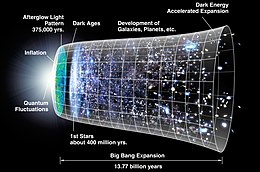
The Universe represented as multiple disk-shaped slices across time, which passes from left to right.
Science (from the Latin word scientia, meaning "knowledge")[1] is a systematic enterprise that builds and organizes knowledge in the form of testable explanations and predictions about the universe.[2][3][4]
The earliest roots of science can be traced to Ancient Egypt and Mesopotamia in around 3500 to 3000 BCE.[5][6] Their contributions to mathematics, astronomy, and medicine entered and shaped Greek natural philosophy of classical antiquity, whereby formal attempts were made to provide explanations of events in the physical world based on natural causes.[5][6] After the fall of the Western Roman Empire, knowledge of Greek conceptions of the world deteriorated in Western Europe during the early centuries (400 to 1000 CE) of the Middle Ages[7] but was preserved in the Muslim world during the Islamic Golden Age.[8] The recovery and assimilation of Greek works and Islamic inquiries into Western Europe from the 10th to 13th century revived "natural philosophy",[7][9] which was later transformed by the Scientific Revolution that began in the 16th century[10] as new ideas and discoveries departed from previous Greek conceptions and traditions.[11][12][13][14] The scientific method soon played a greater role in knowledge creation and it was not until the 19th century that many of the institutional and professional features of science began to take shape;[15][16][17] along with the changing of "natural philosophy" to "natural science."[18]
Modern science is typically divided into three major branches that consist of the natural sciences (e.g., biology, chemistry, and physics), which study nature in the broadest sense; the social sciences (e.g., economics, psychology, and sociology), which study individuals and societies; and the formal sciences (e.g., logic, mathematics, and theoretical computer science), which study abstract concepts. There is disagreement,[19][20] however, on whether the formal sciences actually constitute a science as they do not rely on empirical evidence.[21] Disciplines that use existing scientific knowledge for practical purposes, such as engineering and medicine, are described as applied sciences.[22][23][24][25]
Science is based on research, which is commonly conducted in academic and research institutions as well as in government agencies and companies. The practical impact of scientific research has led to the emergence of science policies that seek to influence the scientific enterprise by prioritizing the development of commercial products, armaments, health care, and environmental protection.
Contents
- 1History
- 2Branches of science
- 3Scientific research
- 4Scientific community
- 5Science and the public
- 6See also
- 7Notes
- 8References
- 9Further reading
- 10External links
Main article: History of science
Science in a broad sense existed before the modern era and in many historical civilizations.[26] Modern science is distinct in its approach and successful in its results, so it now defines what science is in the strictest sense of the term.[3][5][27] Science in its original sense was a word for a type of knowledge, rather than a specialized word for the pursuit of such knowledge. In particular, it was the type of knowledge which people can communicate to each other and share. For example, knowledge about the working of natural things was gathered long before recorded history and led to the development of complex abstract thought. This is shown by the construction of complex calendars, techniques for making poisonous plants edible, public works at national scale, such as those which harnessed the floodplain of the Yangtse with reservoirs,[28] dams, and dikes, and buildings such as the Pyramids. However, no consistent conscious distinction was made between knowledge of such things, which are true in every community, and other types of communal knowledge, such as mythologies and legal systems. Metallurgy was known in prehistory, and the Vinča culture was the earliest known producer of bronze-like alloys. It is thought that early experimentation with heating and mixing of substances over time developed into alchemy.
Early culturesMain article: History of science in early cultures
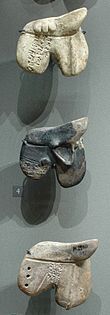
Clay models of animal livers dating between the nineteenth and eighteenth centuries BCE, found in the royal palace in Mari, Syria
Neither the words nor the concepts "science" and "nature" were part of the conceptual landscape in the ancient near east.[29] The ancient Mesopotamians used knowledge about the properties of various natural chemicals for manufacturing pottery, faience, glass, soap, metals, lime plaster, and waterproofing;[30] they also studied animal physiology, anatomy, and behavior for divinatory purposes[30] and made extensive records of the movements of astronomical objects for their study of astrology.[31] The Mesopotamians had intense interest in medicine[30] and the earliest medical prescriptions appear in Sumerian during the Third Dynasty of Ur (c. 2112 BCE – c. 2004 BCE).[32] Nonetheless, the Mesopotamians seem to have had little interest in gathering information about the natural world for the mere sake of gathering information[30] and mainly only studied scientific subjects which had obvious practical applications or immediate relevance to their religious system.[30]
Classical antiquityMain article: History of science in classical antiquity
See also: Nature (philosophy)
In classical antiquity, there is no real ancient analog of a modern scientist. Instead, well-educated, usually upper-class, and almost universally male individuals performed various investigations into nature whenever they could afford the time.[33] Before the invention or discovery of the concept of "nature" (ancient Greek phusis) by the Pre-Socratic philosophers, the same words tend to be used to describe the natural "way" in which a plant grows,[34] and the "way" in which, for example, one tribe worships a particular god. For this reason, it is claimed these men were the first philosophers in the strict sense, and also the first people to clearly distinguish "nature" and "convention."[35]:209 Natural philosophy, the precursor of natural science, was thereby distinguished as the knowledge of nature and things which are true for every community, and the name of the specialized pursuit of such knowledge was philosophy – the realm of the first philosopher-physicists. They were mainly speculators or theorists, particularly interested in astronomy. In contrast, trying to use knowledge of nature to imitate nature (artifice or technology, Greek technē) was seen by classical scientists as a more appropriate interest for artisans of lower social class.[36]
The early Greek philosophers of the Milesian school, which was founded by Thales of Miletus and later continued by his successors Anaximander and Anaximenes, were the first to attempt to explain natural phenomena without relying on the supernatural.[37] The Pythagoreans developed a complex number philosophy[38]:467–68 and contributed significantly to the development of mathematical science.[38]:465 The theory of atoms was developed by the Greek philosopher Leucippus and his student Democritus.[39][40] The Greek doctor Hippocrates established the tradition of systematic medical science[41][42] and is known as "The Father of Medicine".[43]
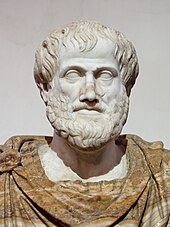
Aristotle, 384–322 BCE, one of the early figures in the development of the scientific method.[44]
A turning point in the history of early philosophical science was Socrates' example of applying philosophy to the study of human matters, including human nature, the nature of political communities, and human knowledge itself. The Socratic method as documented by Plato's dialogues is a dialectic method of hypothesis elimination: better hypotheses are found by steadily identifying and eliminating those that lead to contradictions. This was a reaction to the Sophist emphasis on rhetoric. The Socratic method searches for general, commonly held truths that shape beliefs and scrutinizes them to determine their consistency with other beliefs.[45] Socrates criticized the older type of study of physics as too purely speculative and lacking in self-criticism. Socrates was later, in the words of his Apology, accused of corrupting the youth of Athens because he did "not believe in the gods the state believes in, but in other new spiritual beings". Socrates refuted these claims,[46] but was sentenced to death.[47]: 30e
Aristotle later created a systematic programme of teleological philosophy: Motion and change is described as the actualization of potentials already in things, according to what types of things they are. In his physics, the Sun goes around the Earth, and many things have it as part of their nature that they are for humans. Each thing has a formal cause, a final cause, and a role in a cosmic order with an unmoved mover. The Socratics also insisted that philosophy should be used to consider the practical question of the best way to live for a human being (a study Aristotle divided into ethics and political philosophy). Aristotle maintained that man knows a thing scientifically "when he possesses a conviction arrived at in a certain way, and when the first principles on which that conviction rests are known to him with certainty".[48]
The Greek astronomer Aristarchus of Samos (310–230 BCE) was the first to propose a heliocentric model of the universe, with the Sun at the center and all the planets orbiting it.[49] Aristarchus's model was widely rejected because it was believed to violate the laws of physics.[49] The inventor and mathematician Archimedes of Syracuse made major contributions to the beginnings of calculus[50] and has sometimes been credited as its inventor,[50] although his proto-calculus lacked several defining features.[50] Pliny the Elder was a Roman writer and polymath, who wrote the seminal encyclopedia Natural History,[51][52][53] dealing with history, geography, medicine, astronomy, earth science, botany, and zoology.[51] Other scientists or proto-scientists in Antiquity were Theophrastus, Euclid, Herophilos, Hipparchus, Ptolemy, and Galen.
Medieval science
De potentiis anime sensitive, Gregor Reisch (1504) Margarita philosophica. Medieval science postulated a ventricle of the brain as the location for our common sense,[54]:189 where the forms from our sensory systems commingled.
Further information: Byzantine science, Science in the medieval Islamic world, and European science in the Middle Ages
Because of the collapse of the Western Roman Empire due to the Migration Period an intellectual decline took place in the western part of Europe in the 400s. In contrast, the Byzantine Empire resisted the attacks from invaders, and preserved and improved upon the learning. John Philoponus, a Byzantine scholar in the 500s, questioned Aristotle's teaching of physics and to note its flaws.[55]:pp.307, 311, 363, 402 John Philoponus' criticism of Aristotelian principles of physics served as an inspiration to medieval scholars as well as to Galileo Galilei who ten centuries later, during the Scientific Revolution, extensively cited Philoponus in his works while making the case for why Aristotelian physics was flawed.[55][56]
During late antiquity and the early Middle Ages, the Aristotelian approach to inquiries on natural phenomena was used. Aristotle's four causes prescribed that four "why" questions should be answered in order to explain things scientifically.[57] Some ancient knowledge was lost, or in some cases kept in obscurity, during the fall of the Western Roman Empire and periodic political struggles. However, the general fields of science (or "natural philosophy" as it was called) and much of the general knowledge from the ancient world remained preserved through the works of the early Latin encyclopedists like Isidore of Seville.[58] However, Aristotle's original texts were eventually lost in Western Europe, and only one text by Plato was widely known, the Timaeus, which was the only Platonic dialogue, and one of the few original works of classical natural philosophy, available to Latin readers in the early Middle Ages. Another original work that gained influence in this period was Ptolemy's Almagest, which contains a geocentric description of the solar system.
During late antiquity, in the Byzantine empire many Greek classical texts were preserved. Many Syriac translations were done by groups such as the Nestorians and Monophysites.[59] They played a role when they translated Greek classical texts into Arabic under the Caliphate, during which many types of classical learning were preserved and in some cases improved upon.[59][a] In addition, the neighboring Sassanid Empire established the medical Academy of Gondeshapur where Greek, Syriac and Persian physicians established the most important medical center of the ancient world during the 6th and 7th centuries.[60]
The House of Wisdom was established in Abbasid-era Baghdad, Iraq,[61] where the Islamic study of Aristotelianism flourished. Al-Kindi (801–873) was the first of the Muslim Peripatetic philosophers, and is known for his efforts to introduce Greek and Hellenistic philosophy to the Arab world.[62] The Islamic Golden Age flourished from this time until the Mongol invasions of the 13th century. Ibn al-Haytham (Alhazen), as well as his predecessor Ibn Sahl, was familiar with Ptolemy's Optics, and used experiments as a means to gain knowledge.[b][63][64]:463–65 Alhazen disproved Ptolemy's theory of vision,[65] but did not make any corresponding changes to Aristotle's metaphysics. Furthermore, doctors and alchemists such as the Persians Avicenna and Al-Razi also greatly developed the science of Medicine with the former writing the Canon of Medicine, a medical encyclopedia used until the 18th century and the latter discovering multiple compounds like alcohol. Avicenna's canon is considered to be one of the most important publications in medicine and they both contributed significantly to the practice of experimental medicine, using clinical trials and experiments to back their claims.[66]
In Classical antiquity, Greek and Roman taboos had meant that dissection was usually banned in ancient times, but in Middle Ages it changed: medical teachers and students at Bologna began to open human bodies, and Mondino de Luzzi (c. 1275–1326) produced the first known anatomy textbook based on human dissection.[67][68]
By the eleventh century most of Europe had become Christian; stronger monarchies emerged; borders were restored; technological developments and agricultural innovations were made which increased the food supply and population. In addition, classical Greek texts started to be translated from Arabic and Greek into Latin, giving a higher level of scientific discussion in Western Europe.[7]
By 1088, the first university in Europe (the University of Bologna) had emerged from its clerical beginnings. Demand for Latin translations grew (for example, from the Toledo School of Translators); western Europeans began collecting texts written not only in Latin, but also Latin translations from Greek, Arabic, and Hebrew. Manuscript copies of Alhazen's Book of Optics also propagated across Europe before 1240,[69]:Intro. p. xx as evidenced by its incorporation into Vitello's Perspectiva. Avicenna's Canon was translated into Latin.[70] In particular, the texts of Aristotle, Ptolemy,[c] and Euclid, preserved in the Houses of Wisdom and also in the Byzantine Empire,[71] were sought amongst Catholic scholars. The influx of ancient texts caused the Renaissance of the 12th century and the flourishing of a synthesis of Catholicism and Aristotelianism known as Scholasticism in western Europe, which became a new geographic center of science. An experiment in this period would be understood as a careful process of observing, describing, and classifying.[72] One prominent scientist in this era was Roger Bacon. Scholasticism had a strong focus on revelation and dialectic reasoning, and gradually fell out of favour over the next centuries, as alchemy's focus on experiments that include direct observation and meticulous documentation slowly increased in importance.
Renaissance and early modern scienceMain article: Scientific Revolution
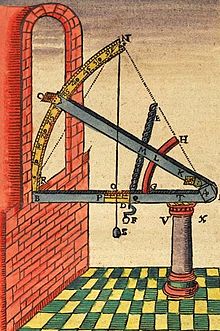
Astronomy became more accurate after Tycho Brahe devised his scientific instruments for measuring angles between two celestial bodies, before the invention of the telescope. Brahe's observations were the basis for Kepler's laws.
New developments in optics played a role in the inception of the Renaissance, both by challenging long-held metaphysical ideas on perception, as well as by contributing to the improvement and development of technology such as the camera obscura and the telescope. Before what we now know as the Renaissance started, Roger Bacon, Vitello, and John Peckham each built up a scholastic ontology upon a causal chain beginning with sensation, perception, and finally apperception of the individual and universal forms of Aristotle.[73] A model of vision later known as perspectivism was exploited and studied by the artists of the Renaissance. This theory uses only three of Aristotle's four causes: formal, material, and final.[74]
In the sixteenth century, Copernicus formulated a heliocentric model of the solar system unlike the geocentric model of Ptolemy's Almagest. This was based on a theorem that the orbital periods of the planets are longer as their orbs are farther from the centre of motion, which he found not to agree with Ptolemy's model.[75]
Kepler and others challenged the notion that the only function of the eye is perception, and shifted the main focus in optics from the eye to the propagation of light.[74][76]:102 Kepler modelled the eye as a water-filled glass sphere with an aperture in front of it to model the entrance pupil. He found that all the light from a single point of the scene was imaged at a single point at the back of the glass sphere. The optical chain ends on the retina at the back of the eye.[d] Kepler is best known, however, for improving Copernicus' heliocentric model through the discovery of Kepler's laws of planetary motion. Kepler did not reject Aristotelian metaphysics, and described his work as a search for the Harmony of the Spheres.
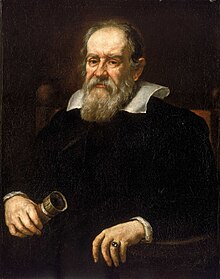
Galileo Galilei, regarded as the father of modern science.[77]: Vol. 24, No. 1, p. 36
Galileo made innovative use of experiment and mathematics. However, he became persecuted after Pope Urban VIII blessed Galileo to write about the Copernican system. Galileo had used arguments from the Pope and put them in the voice of the simpleton in the work "Dialogue Concerning the Two Chief World Systems", which greatly offended Urban VIII.[78]
In Northern Europe, the new technology of the printing press was widely used to publish many arguments, including some that disagreed widely with contemporary ideas of nature. René Descartes and Francis Bacon published philosophical arguments in favor of a new type of non-Aristotelian science. Descartes emphasized individual thought and argued that mathematics rather than geometry should be used in order to study nature. Bacon emphasized the importance of experiment over contemplation. Bacon further questioned the Aristotelian concepts of formal cause and final cause, and promoted the idea that science should study the laws of "simple" natures, such as heat, rather than assuming that there is any specific nature, or "formal cause", of each complex type of thing. This new science began to see itself as describing "laws of nature". This updated approach to studies in nature was seen as mechanistic. Bacon also argued that science should aim for the first time at practical inventions for the improvement of all human life.
Age of EnlightenmentMain article: Age of Enlightenment

Isaac Newton, shown here in a 1689 portrait, made seminal contributions to classical mechanics, gravity, and optics. Newton shares credit with Gottfried Leibniz for the development of calculus.
As a precursor to the Age of Enlightenment, Isaac Newton and Gottfried Wilhelm Leibniz succeeded in developing a new physics, now referred to as classical mechanics, which could be confirmed by experiment and explained using mathematics (Newton (1687), Philosophiæ Naturalis Principia Mathematica). Leibniz also incorporated terms from Aristotelian physics, but now being used in a new non-teleological way, for example, "energy" and "potential" (modern versions of Aristotelian "energeia and potentia"). This implied a shift in the view of objects: Where Aristotle had noted that objects have certain innate goals that can be actualized, objects were now regarded as devoid of innate goals. In the style of Francis Bacon, Leibniz assumed that different types of things all work according to the same general laws of nature, with no special formal or final causes for each type of thing.[79] It is during this period that the word "science" gradually became more commonly used to refer to a type of pursuit of a type of knowledge, especially knowledge of nature – coming close in meaning to the old term "natural philosophy."
During this time, the declared purpose and value of science became producing wealth and inventions that would improve human lives, in the materialistic sense of having more food, clothing, and other things. In Bacon's words, "the real and legitimate goal of sciences is the endowment of human life with new inventions and riches", and he discouraged scientists from pursuing intangible philosophical or spiritual ideas, which he believed contributed little to human happiness beyond "the fume of subtle, sublime, or pleasing speculation".[80]
Science during the Enlightenment was dominated by scientific societies[81] and academies, which had largely replaced universities as centres of scientific research and development. Societies and academies were also the backbone of the maturation of the scientific profession. Another important development was the popularization of science among an increasingly literate population. Philosophes introduced the public to many scientific theories, most notably through the Encyclopédie and the popularization of Newtonianism by Voltaire as well as by Émilie du Châtelet, the French translator of Newton's Principia.
Some historians have marked the 18th century as a drab period in the history of science;[82] however, the century saw significant advancements in the practice of medicine, mathematics, and physics; the development of biological taxonomy; a new understanding of magnetism and electricity; and the maturation of chemistry as a discipline, which established the foundations of modern chemistry.
Enlightenment philosophers chose a short history of scientific predecessors – Galileo, Boyle, and Newton principally – as the guides and guarantors of their applications of the singular concept of nature and natural law to every physical and social field of the day. In this respect, the lessons of history and the social structures built upon it could be discarded.[83]
19th century
Charles Darwin in 1854, by then working towards publication of On the Origin of Species.
The nineteenth century is a particularly important period in the history of science since during this era many distinguishing characteristics of contemporary modern science began to take shape such as: transformation of the life and physical sciences, frequent use of precision instruments, emergence of terms like "biologist", "physicist", "scientist"; slowly moving away from antiquated labels like "natural philosophy" and "natural history", increased professionalization of those studying nature lead to reduction in amateur naturalists, scientists gained cultural authority over many dimensions of society, economic expansion and industrialization of numerous countries, thriving of popular science writings and emergence of science journals.[17]
Early in the 19th century, John Dalton suggested the modern atomic theory, based on Democritus's original idea of individible particles called atoms.

Combustion and chemical reactions were studied by Michael Faraday and reported in his lectures before the Royal Institution: The Chemical History of a Candle, 1861.
Both John Herschel and William Whewell systematized methodology: the latter coined the term scientist.[84] When Charles Darwin published On the Origin of Species he established evolution as the prevailing explanation of biological complexity. His theory of natural selection provided a natural explanation of how species originated, but this only gained wide acceptance a century later.
The laws of conservation of energy, conservation of momentum and conservation of mass suggested a highly stable universe where there could be little loss of resources. With the advent of the steam engine and the industrial revolution, there was, however, an increased understanding that all forms of energy as defined in physics were not equally useful: they did not have the same energy quality. This realization led to the development of the laws of thermodynamics, in which the free energy of the universe is seen as constantly declining: the entropy of a closed universe increases over time.
The electromagnetic theory was also established in the 19th century, and raised new questions which could not easily be answered using Newton's framework. The phenomena that would allow the deconstruction of the atom were discovered in the last decade of the 19th century: the discovery of X-rays inspired the discovery of radioactivity. In the next year came the discovery of the first subatomic particle, the electron.
20th century
The DNA double helix is a molecule that encodes the genetic instructions used in the development and functioning of all known living organisms and many viruses.
Einstein's theory of relativity and the development of quantum mechanics led to the replacement of classical mechanics with a new physics which contains two parts that describe different types of events in nature.
In the first half of the century, the development of antibiotics and artificial fertilizer made global human population growth possible. At the same time, the structure of the atom and its nucleus was discovered, leading to the release of "atomic energy" (nuclear power). In addition, the extensive use of technological innovation stimulated by the wars of this century led to revolutions in transportation (automobiles and aircraft), the development of ICBMs, a space race, and a nuclear arms race.
The molecular structure of DNA was discovered in 1953. The discovery of the cosmic microwave background radiation in 1964 led to a rejection of the Steady State theory of the universe in favour of the Big Bang theory of Georges Lemaître.
The development of spaceflight in the second half of the century allowed the first astronomical measurements done on or near other objects in space, including manned landings on the Moon. Space telescopes lead to numerous dis
